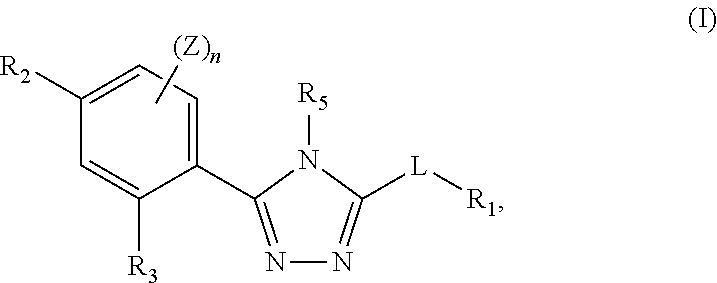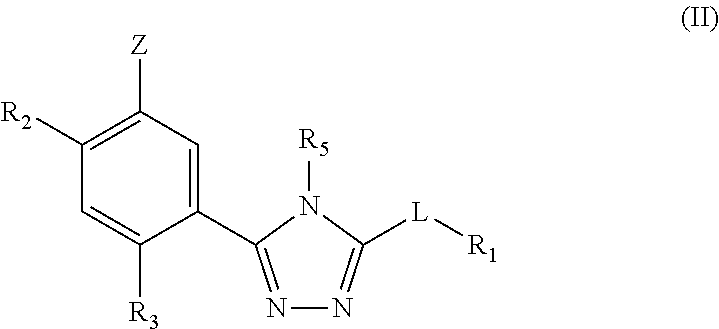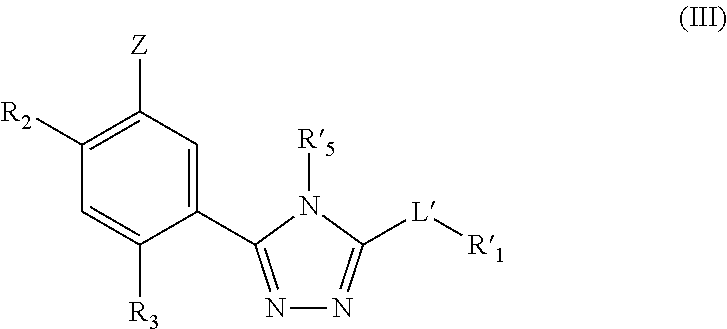Triazole compounds that modulate HSP90 activity
a technology of hsp90 activity and triazole, which is applied in the direction of antibacterial agents, immune disorders, extracellular fluid disorders, etc., can solve the problems of unsatisfactory current chemotherapy, dismal prognosis for the majority of patients diagnosed with cancer, and the inability to fully implement a therapeutic agent that acts on one molecular targ
- Summary
- Abstract
- Description
- Claims
- Application Information
AI Technical Summary
Benefits of technology
Problems solved by technology
Method used
Image
Examples
example 1
Compound 7:
General procedure:
[0888]
[0889]To a stirred suspension of 1.10 g (2.90 mmols) of 4-isopropyl-6-(5-mercapto-4-(1-methyl-1H-indol-5-yl)-4H-1,2,4-triazol-3-yl)benzene-1,3-diol, 2.0 g (14.45 mmols) of K2CO3 in 25 mL of anhydrous DMF was added 0.48 g (2.89 mmols) of 3-picolyl chloride hydrochloride portion wise, over 2 min. The reaction mixture was stirred at room temperature for 2 h and diluted with 50 mL of water. The resultant solution was then adjusted to pH 7 approximately with saturated NH4Cl solution and the white precipitate was extracted with ethyl acetate (15 mL×3) and the combined extracts were washed with water (10 mL×4) and dried over anhydrous Na2SO4. The solution was then filtered through a short pad of silica gel and concentrated. The crude product thus obtained was then reprecipitated using anhydrous ether to obtain 1.0 g (74%) of the product Compound 7 as an off white solid.
[0890]1H NMR (300 MHz, DMSO-D6) δ 10.91 (s, 1H), 9.71 (s, 1H), 8.57 (d, J=2.1 Hz, 1H), ...
example 4
Inhibition of Hsp90
[0937]Hsp90 protein is obtained from Stressgen (Cat#SPP-770). Assay buffer: 100 mM Tris-HCl, Ph7.4, 20 mM KCl, 6 mM MgCl2. Malachite green (0.0812% w / v) (M9636) and polyvinyl alcohol USP (2.32% w / v) (P1097) are obtained from Sigma. A Malachite Green Assay (see Methods Mol Med, 2003, 85:149 for method details) is used for examination of ATPase activity of Hsp90 protein. Briefly, Hsp90 protein in assay buffer (100 mM Tris-HCl, Ph7.4, mM KCl, 6 mM MgCl2) is mixed with ATP alone (negative control) or in the presence of Geldanamycin (a positive control) or a compound of the invention in a 96-well plate. Malachite green reagent is added to the reaction. The mixtures are incubated at 37° C. for 4 hours and sodium citrate buffer (34% w / v sodium citrate) is added to the reaction. The plate is read by an ELISA reader with an absorbance at 620 nm.
example 5
Degradation of Hsp90 Client Proteins via Inhibition of Hsp90 Activity
A. Cells and Cell Culture
[0938]Human high-Her2 breast carcinoma BT474 (HTB-20), SK-BR-3 (HTB-30) and MCF-7 breast carcinoma (HTB-22) from American Type Culture Collection, VA, USA were grown in Dulbecco's modified Eagle's medium with 4 mM L-glutamine and antibiotics (100 IU / ml penicillin and 100 ug / ml streptomycine; GibcoBRL). To obtain exponential cell growth; cells were trypsinized, counted and seeded at a cell density of 0.5×106 cells / ml regularly, every 3 days. All experiments were performed on day 1 after cell passage.
B. Degradation of Her2 in Cells after Treatment with a Compound of the Invention
[0939]1. Method 1
[0940]BT-474 cells are treated with 0.5 μM, 2 μM, or 5 μM of 17AAG (a positive control) or 0.5 μM, 2 μM, or 5 μM of a compound of the invention overnight in DMEM medium. After treatment, each cytoplasmic sample is prepared from 1×106 cells by incubation of cell lysis buffer (#9803, cell Signaling Tech...
PUM
| Property | Measurement | Unit |
|---|---|---|
| weight percent | aaaaa | aaaaa |
| weight percent | aaaaa | aaaaa |
| weight percent | aaaaa | aaaaa |
Abstract
Description
Claims
Application Information
 Login to View More
Login to View More - R&D
- Intellectual Property
- Life Sciences
- Materials
- Tech Scout
- Unparalleled Data Quality
- Higher Quality Content
- 60% Fewer Hallucinations
Browse by: Latest US Patents, China's latest patents, Technical Efficacy Thesaurus, Application Domain, Technology Topic, Popular Technical Reports.
© 2025 PatSnap. All rights reserved.Legal|Privacy policy|Modern Slavery Act Transparency Statement|Sitemap|About US| Contact US: help@patsnap.com



